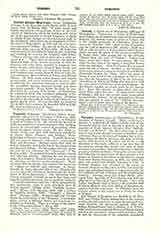

Toronto, Archdiocese of (TORONTINA), in the Province of Ontario, Canada. When constituted a diocese, it embraced all Upper Canada west of the Newcastle district, but at present is limited to the counties of York, Simcoe, Ontario, Peel, Dufferin, Lincoln, and Welland. The first missionary in this district was Father Joseph Le Caron, a Recollect, who celebrated Mass on the shore of Georgian Bay in 1615. Thus began the Huron missions, the story of which replete with heroism of Recollect and Jesuit, is told elsewhere in this work; suffice it to say here that all the missions among that people and some of those attempted among their Neutral kindred lay within the present archdiocesan limits. During the century and a half following the destruction of these nations, a few priests are known to have been in this district; among these were Father Hennepin, in 1678, and Abbé Picquet, who visited Fort Rouillé (Toronto) in 1752. A Catholic chaplain was attached to the troops at Newark (Niagara-on-the-Lake) in 1794, and about the same time missionaries began to visit occasionally the few Catholics of York (Toronto) and the neighboring territory. Amongst these was Father Burke, afterwards Vicar Apostolic of Nova Scotia, who held the office of Vicar-General of Upper Canada. After 1804 Father Macdonell came as often as his extended field of labor allowed, and, when Bishop of Kingston, resided at York for some years. In 1826 there were two resident priests in this region, one at York, the other at Niagara.
The Diocese of Kingston was divided on December 17,1841, and Father Power, bishop-elect of the western portion, having permission to name his episcopal city, chose Toronto, the provincial capital. This first bishop, Michael Power, born at Halifax, N. S., October 17, 1804, was Vicar-General of the Diocese of Montreal when raised to the episcopate. Consecrated on May 8, 1842, he laid the cornerstone of the cathedral, introduced the Jesuits, and made arrangements to bring the Loreto nuns to the diocese. Appointed by the Government to the Council of Public Instruction, he presided over that body. He died on October 1, 1847, of typhus contracted while attending the immigrants at the fever-sheds. His successor, Armand-François-Marie Comte de Charbonnel, a Sulpician, born at Monistrol-sur-Loire, France, December 1, 1802, was consecrated by Pius IX in the Sistine Chapel, May 26, 1850. He gave his paternal estates to liquidate the debts of his diocese, introduced the Basilians (Annonay), the Brothers of the Christian Schools, and Sisters of St. Joseph, and was present at the First and Second Provincial Councils of Quebec. His diocese was divided in 1856 by the erection of Hamilton and London as sees. With his fellow-bishops of Upper Canada, he engaged in the struggle for separate schools, which had a successful outcome under his successor. In 1860 he resigned to join the Capuchins, being appointed titular Bishop of Sozopolis, and afterwards titular archbishop of the same see. He died on March 29, 1891. His successor at Toronto was John Joseph Lynch, C. M., who was born, at Clones, County Monaghan, Ireland February 6, 1816. As a Lazarist, he did missionary and professorial work in Ireland and the United States, being rector of a seminary which he founded at Niagara Falls, New York, when appointed (August 26, 1859) titular Bishop of Aechinas, and coadjutor with right of succession to Bishop de Charbonnel.
On the resignation of Bishop de Charbonnel on April 26, 1860, Bishop Lynch became Bishop of Toronto. He brought to the diocese the Redemptorists, Carmelites, Sisters of the Precious Blood, and Sisters of Our Lady of Charity of Refuge; was present at the Third and Fourth Provincial Councils of Quebec; and also at the Council of the Vatican, where he favored the immediate promulgation of Papal Infallibility, and acted on the commissions on missions and Oriental rites. During the council (March 18, 1870) his diocese was raised to metropolitan rank. He died on May 12, 1888. In 1879 Archbishop Lynch received as auxiliary Timothy O’Mahony, titular Bishop of Eudocia and former Bishop of Armidale, Australia, who died on September 8, 1892. John Walsh, second archbishop, born at Mooncoin, County Kilkenny, Ireland, May 23, 1830, was ordained for the Diocese of Toronto, of which he was vicar-general when appointed Bishop of Sandwich in 1867. On August 13, 1889, he became Archbishop of Toronto, where he renovated the cathedral, and founded St. John’s Industrial School. The Irish Race Convention of 1896 was organized at his suggestion. He was noted as a writer and preacher. His death occurred on July 31, 1898. Denis O’Connor, C.S.B., his successor, was born at Pickering, Ontario, March 28, 1841. A Basilian, he taught for several years in that community, being superior of the Assumption College, Sandwich, when chosen Bishop of London, Ontario, where he was consecrated on October 19, 1890. On January 27, 1899, he was created Archbishop of Toronto. Here he established several new parishes, gave special attention to conferences for the clergy and to the study of Christian doctrine by the young. In 1908 he resigned, being appointed titular Archbishop of Laodicea. He died at St. Basil’s Novitiate, Toronto, June 30, 1911. His successor, Fergus Patrick McEvay, was born at Lindsay, Ontario, December 8, 1856. Ordained for Kingston, he was transferred to the new Diocese of Peterborough, where he was rector of the cathedral, and then went to Hamilton with Bishop Dowling. There he was appointed rector of the cathedral and vicar-general, and received the papal honors of private chamberlain and domestic prelate. Consecrated Bishop of London, Ontario, August 6, 1899, he was promoted to Toronto, April 13, 1908. He founded new parishes, rebuilt the cathedral palace, erected a new archiepiscopal residence, and began St. Augustine’s Seminary, donated by Mr. Eugene O’Keefe (private chamberlain to His Holiness). At the First National Council of Canada, Archbishop McEvay was chairman of the commission ad novas materias; he was also instrumental in founding the Catholic Church Extension Society of Canada. He died on May 10, 1911.
Civil incorporation took place on March 25, 1845, under the title of “The Roman Catholic Episcopal Corporation for the Diocese of Toronto in Canada“. All ecclesiastical property in the archdiocese, except that belonging to religious communities, is vested in this corporation. There have been three synods (1842, 1863, 1882) and one provincial council (1875). Both clergy and people are for the most part of Irish extraction, with a small percentage of English and Scotch. There are however three parishes exclusively French, three mixed (French and English), 1 for Poles, Italians, Ruthenians, and Syrians, respectively, and one Indian mission. In the archdiocese are 58 churches with resident pastors and 37 mission churches, 81 diocesan priests, and 39 of religious orders or communities; 39 separate schools, 2 high schools, 6 academies, 2 industrial schools, 1 domestic science school, 1 college for young men, 2 ladies’ colleges, and 1 diocesan seminary (in course of erection). There are 8009 children in the schools and institutions. The Catholic population is about 70,000. The Basilian have St. Michael’s College, 1 novitiate and scholasticate, 2 parishes and 2 missions; the Carmelites, a monastery, novitiate, and house of studies, 2 parishes and 1 mission; the Jesuits, 1 parish, 1 Indian mission, 2 other missions and a memorial chapel on the spot where Fathers de Brébeuf and Lalement were killed; the Redemptorists, 1 monastery and 1 parish (they also give missions throughout the province). The Brothers of the Christian Schools have the De La Salle Institute, St. John’s Industrial School, a junior novitiate, and 6 separate schools; the Institute of the Blessed Virgin (Sisters of Loreto), the mother-house for America, a novitiate, a ladies’ college, 3 academies, 6 separate schools, and 1 domestic science school; the Sisters of St. Joseph, their mother-house and novitiate, a ladies’ college, 3 academies, 1 high school, 21 separate schools, a House of Providence for the aged poor, St. Vincent’s Home for Infants, Sacred Heart Orphanage, and St. Michael’s Hospital; the Sisters of Our Lady of Charity of Refuge, a convent and novitiate, a girls’ industrial school and refuge; the Sisters Adorers of the Precious Blood, a novitiate and convent. The chaplaincies of the central prison, the reformatory for women (each of which has a Catholic chapel), and the hospitals for the insane belong to St. Michael’s Cathedral, but are temporarily filled by the Basilians. The jails, hospitals, and military barracks are attended by the parochial clergy of their respective districts.
The city of Toronto has a population of 376,240 (about 45,000 Catholics), and is an educational and commercial center. There are 22 city parishes, with 40 secular and 12 regular priests. St. Michael’s Cathedral, modeled after York Minster, is of the Gothic style of the fourteenth century. It was solemnly dedicated on September 29, 1848. Toronto University has Catholic representatives on its Board of Governors, Senate, and Staff, and Catholic students under the various faculties. Federated with this institution is St. Michael’s College. Catholic pedagogical students attend the provincial normal school and faculty of education. There are sodalities and confraternities in every parish, as well as Catholic fraternal and benefit societies. The Catholic Church Extension Society of Canada aids the Northern and Western missions; St. Vincent de Paul Society relieves the poor; a Children’s Aid Society under the same patron protects children of dissolute parents; the St. Elizabeth Nurses’ Association cares for the sick in their homes. The Catholic Truth Society and the Holy Name Society are strongly established. The priests have a Eucharistic League and also a society which cares for infirm members of the clergy.
EDW. KELLY

